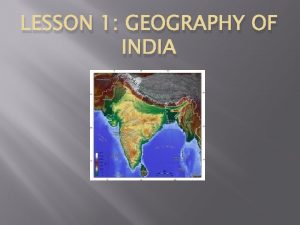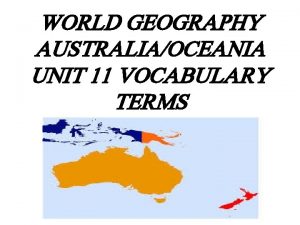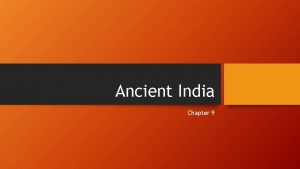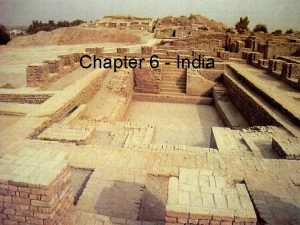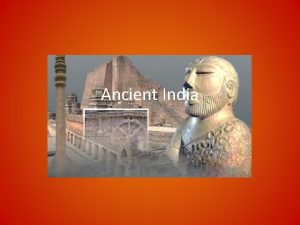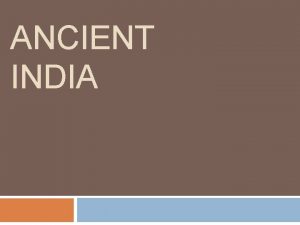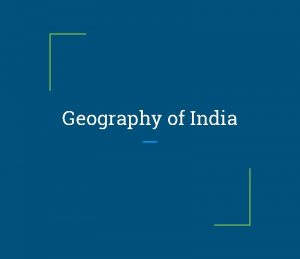Chapter 6 India Geography of India India is








- Slides: 8

Chapter 6 - India

Geography of India • India is a subcontinent which encompasses the modern-day nations of Nepal, Pakistan, Bhutan, India, Bangladesh, and Sri Lanka. (india. gov) • The most dramatic source of water is the seasonal monsoon, which begins in June. (Bulliet, 152) • India is characterized by mountains, steep foothills, and tall meadows. • Because of India’s climate and geographical location, up to three harvests a year are possible. (culturalindia. net) • Migration of Indo-Europeans into northwest India began in 1500 B. C. E.

• Many historians believe that nomadic warriors migrated into northwest India around 1500 B. C. E. • Varna evolved in India. This was a ranking system that placed individuals into one of four social classes: Brahmin, which was composed of scholars and priests; Kshatriya, which were warriors and officials; Vaishya, landowners, merchants, and artists; and finally Shudra, which were basically slaves. A fifth group called Untouchables later evolved, which was composed of people who tanned leather or touched dead animals. (Bulliet, 154) • Buddhism and Jainism were the two key religions up until around the 9 th century. Hinduism evolved in the Vedic period, and became the main religion in Inidia. (culturalindia. net) • Warfare in ancient India centered around the chariot; Also, the Indians were the first to use the elephant in battle, which occurred in 1500 B. C. E. • The Mauryan empire was the first to unite all of India. It was composed of different structures, ranging from elephant (gaja), to infantry (pada). (allempires. com)

• Some rulers of the Mauryan Empire after the death of Alexander the Great were Chandragupta (324 -301 B. C. E. ); Bindusara (301 -269 B. C. E. ); and Ashoka (269 -232 B. C. E. ) • There were taxes during this period in India, some as high as 25%. (Bulliet, 160) • The later part of the 4 th century C. E. saw the formation of Maha Janapadas, which were kingdoms in the Vedic period. (ancientindia. co. uk) • During the Vedic period, art was greatly influence by religion and society. Many sculptures were of their gods or dieties, which they worshipped. (culturalindia. net) • A common form of worship was called puja, which involved bathing, clothing, and feeding the diety’s statues.

• • • The individual pursuit of insight had characteristics such as physical/mental discipline, special diets, and meditation. (Bulliet, 156) Hinduism is a polytheistic religion, and is/was the largest in Indian history. Polytheistic religions are the beliefs of multiple deities, gods, and goddesses. The religious duties of Hindu men were to: become a student and study texts, become a householder and have children, give up the household when grandchildren are born, and to finally abandon his personal identity and await death as a wandering ascetic. (culturalindia. net) Hindu religious sculptures were half Shiva, half Vishnu. This was so that they were complementary to each other and represented one common principle. The pre-existing religions, Christianity and Buddhism, were monotheistic and non-theistic, respectively.

• • The Gupta period occurred in the early 4 th century C. E. (Bulliet, 162) During the Gupta period, mathematics was immensely advanced. (thisismyindia. com) Indian scholar Panini made great strides in linguistics, developing a formal, literary language. During this time was a period of “political fragmentation. ” The Andhra dynasty, Deccan Plateau, and the three Tamil kingdoms were important states in central India during this time. The Indians had adventurous merchants, who traded items such as cotton cloth, metalwork, and exotic animals for Chinese silk and spices. By the late 5 th century (550 C. E. ), the Huns overtook the Gupta empire, with their tremendous army and military tactics. (india. gov) (Staute is that of the Gupta)

- People in the fifth group of Varna were called: A) Vaishya B) Untouchables C) Shudra D) Pada E) There was no 5 th group - When did the Gupta Empire fall, and who overtook it? A) 400 C. E. , the Huns B) 650 C. E. , the Mauryans C) 500 B. C. E. , the Mauryans D) 550 C. E. , the Huns E) 217 C. E. , the Shangs - What was a form of worship in which you clothed, bathed, or fed statues of dieties ? A) Puja B) Vishnu C) Devi D) Hinduism E) Maha

Bibliography Books: 1) “The Earth and Its Peoples” by Bulliet; copyright 2005 Websites: 1) http: //www. culturalindia. net/indian-history/ancient-india/ancientreligion. html 2) http: //www. allempires. com/article/index. php? q=military_ancient_india 3) http: //www. thisismyindia. com/ancient_india/ancient-indiatechnology. html 4) http: //www. india. gov 5) http: //www. ancientindia. co. uk 6) http: //www. asianinfo. org




